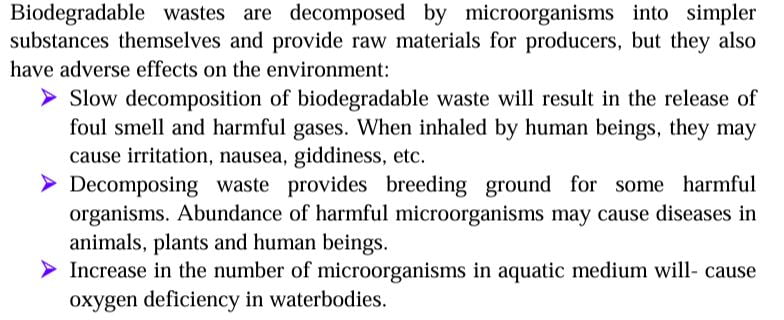Table of Contents
ToggleNCERT Solutions Class 10 Science Chapter 13 (Our Environment)
NCERT Solutions for Class 10 Science Chapter 13 Intext Questions
NCERT Solutions Class 10 Science Chapter 13 (Our Environment)
Page Number: 212
Question 1
What are trophic levels ? Give an example of food chain and state the different trophic levels in it.
Answer:

Question 2
What is the role of decomposers in the ecosystem ?
Answer:

NCERT Solutions Class 10 Science Chapter 13 (Our Environment)
Page Number: 214
Question 1
Why are some substances biodegradable and some non-biodegradable ?
Answer:

Question 2
Give any two ways in which biodegradable substances would affect the environment.
Answer:

Question 3
Give any two ways in which non-biodegradable substances would effect the environment.
Answer:

NCERT Solutions Class 10 Science Chapter 13 (Our Environment)
Page Number: 216
Question 1
What is ozone and how does it affect any ecosystem ?
Answer:

Question 2
How can you help in reducing the problem of waste disposal ? Give any two methods.
Answer:

NCERT Solutions for Class 10 Science Chapter 13 Exercise Questions (Textbook Chapter End Questions)
NCERT Solutions Class 10 Science Chapter 13 (Our Environment)
Question 1
Which of the following groups contain only biodegradable item ?
(a) Grass, flowers and leather
(b) Grass, wood and plastic
(c) Fruit peels, cake and lime juice
(d) Cake, wood and grass
Answer:
Question 2
Which of the following constitutes a food-chain ?
(a) Grass, wheat and mango
(b) Grass, goat and human
(c) Goat, cow and elephant
(d) Grass, fish and goat
Answer:
Question 3
Which of the following are environment friendly practices ?
(a) Carrying cloth-bags to put purchases in while shopping
(b) Switching off unnecessary lights and fans
(c) Walking to school instead of getting your mother to drop on her scooter
(d) All of the above
Answer:
Question 4
What will happen if we kill all the organisms in one trophic level?
Answer:

Question 5
Will the impact of removing all the organisms in a trophic level be different for different trophic levels? Can the organisms of any trophic level be removed without causing any damage to the ecosystem?
Answer:

Question 6
What is biological magnification? Will the levels of this magnification be different at different levels of the ecosystem?
Answer:

Question 7
What are the problems caused by the non- biodegradable wastes that we generate?
Answer:

Question 8
If all the waste we generate is biodegradable, will this have no impact on the environment?
Answer:

Question 9
Why is damage to the ozone layer a cause for concern? What steps are being taken to limit this damage?
Answer:


Light Reflection and Refraction in NCERT Solutions Class 10 Science Chapter 13 (Our Environment): You candidates may obtain class 10 NCERT solutions for electricity in this page. Practicing the light chapter of the Class 10 NCERT answers will assist candidates in developing a solid understanding of Physics. Understanding class 10 questions and answers related to light reflection and refraction will also help students achieve a respectable grade on their class 10 board exams.
This post contains class 10 numerical problems related to light reflection and refraction in addition to the NCERT Solutions Class 10 Science Chapter 13 (Our Environment). Examining them will provide candidates a clear understanding of how to approach the difficulties, which will enable you to find the most effective solution. Why then wait? Discover everything there is to know about light reflection and refraction in class 10 by reading on for key questions and answers.
The organisation of NCERT Solutions Class 10 Science Chapter 13 (Our Environment) presents a clear overview of scientific subjects that are relevant to everyday life. Students have been taught basic science with no clear distinctions between subjects like biology, chemistry, and physics. All of the country’s schools acknowledge and promote NCERT. Here are some explanations for why you should trust NCERT Solutions:
Students are forced to think creatively and apply the principles they have learnt in the chapter by the challenging questions that are put between the chapters.
You may get comprehensive answers to the chapter problems in NCERT Solutions, which will help you do well on the CBSE exams.
Students like using NCERT Solutions, particularly in the subjects of science and maths. This section contains the NCERT Solutions Class 10 Science Chapter 13 (Our Environment). The solutions to all of the problems in the textbook are clearly explained. Get the complete set of NCERT Solutions for Light Reflection and Refraction in Chapter 10 here for free!
One of the most significant chapters in Class 10 Science is NCERT Solutions Class 10 Science Chapter 13 (Our Environment). The most recent marking scheme assigns a weightage of 7 marks to this chapter. Students will gain a thorough understanding of light phenomena including refraction and reflection in Class 10 Science’s NCERT Solutions Class 10 Science Chapter 13 (Our Environment) Drawing ray diagrams, spherical mirrors, and image generation will all be covered.
Ever wonder why certain things are visible to us? Light is the answer to the query. Sunlight aids in our ability to see items during the day. An item reflects light when it hits it. When this reflected light reaches our eyes, it aids in our ability to see. Light is responsible for many amazing occurrences, like the birth of stars and rainbows, among many others. Let’s examine the phenomena of refraction and reflection utilising the straight-line propagation of light in NCERT Solutions Class 10 Science Chapter 13 (Our Environment). In this chapter, we will also attempt to comprehend how spherical mirrors reflect light by utilising the NCERT Solutions from Bhautik Study.
NCERT Solutions Class 10 Science Chapter 13 (Our Environment): Key Elements of the NCERT Solutions
offers thorough responses to every query posed in the chapter.
The material offered is accurate and suitable, and the language used is clear and understandable to all.
You can use these solutions for Olympiads, CBSE exams, and other competitive exams.
Students are given concise responses to aid in their understanding.